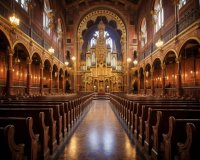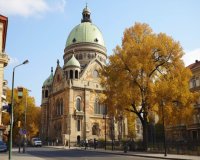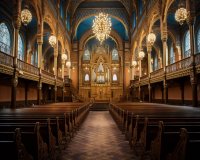Discover Jewish History in Budapest on a Walking Tour
Budapest, the capital of Hungary, is a city rich in history and culture, with a significant Jewish heritage that dates back centuries. Exploring the Jewish history of Budapest is a fascinating journey that offers insights into the lives, struggles, and triumphs of the Jewish community in the heart of Europe.
The Jewish Quarter:
The Jewish Quarter in Budapest is a central hub for Jewish heritage. Located in the historic center, it is home to numerous landmarks and historical sites that shed light on the Jewish community's history. One of the key sites is the Dohány Street Synagogue, also known as the Great Synagogue. This grand architectural marvel is a symbol of the resilience and vibrancy of the Jewish community in Budapest.
Additionally, the Jewish Quarter features the Jewish Museum, which showcases a vast collection of artifacts, documents, and memorabilia related to Jewish life in Hungary. Visitors can learn about Jewish traditions, customs, and the impact of Jewish culture on Budapest and Hungary as a whole.
Walking Tours:
Embarking on a walking tour is an excellent way to discover the rich Jewish history of Budapest. Knowledgeable guides lead visitors through the Jewish Quarter, providing in-depth insights into the history, architecture, and stories of the community. These tours often include visits to significant sites such as the Great Synagogue, the Raoul Wallenberg Holocaust Memorial Park, and the Jewish Museum.
During the tour, visitors can learn about the challenges faced by the Jewish community, including the atrocities of World War II and the Holocaust. The tour guides share stories of resilience, survival, and the efforts to rebuild the community in the aftermath of devastating events.
The Holocaust Memorial Center:
Another essential stop on a Jewish history tour of Budapest is the Holocaust Memorial Center. This powerful institution is dedicated to commemorating the Holocaust and honoring the memory of the victims. It provides a somber yet crucial educational experience, allowing visitors to reflect on the Holocaust's impact and the importance of tolerance and understanding.
Conclusion:
Exploring Jewish history in Budapest through a walking tour offers a meaningful and educational experience. It allows visitors to understand the profound influence of the Jewish community on the city's history and culture. The preservation of Jewish heritage in Budapest serves as a reminder of the importance of remembering and learning from the past.
Jewish Budapest: Exploring Alternative Jewish Experiences
Discover the rich tapestry of Jewish life in Budapest on this insightful 3-hour historical walking tour. Led by a knowledgeable historian, delve deep into the Jewish experience before WWII, uncovering hidden gems and lesser-known stories that go beyond the typical tourist trails.
Embark on a journey through time, exploring significant sites that shaped Budapest's Jewish community:
1. Buda Castle and Medieval Jewry:
Explore the traces of a vibrant Jewish settlement alongside the rise of Buda Castle Hill, a center of political power from 1100 to 1200. Uncover remnants of the medieval synagogue, offering a glimpse into the early Jewish community's life.
2. Óbuda Synagogue and Cultural Affluence:
Visit the elegant Classicist Óbuda Synagogue, built in 1821, representing the economic and cultural wealth of Hungarian Jews. Discover how this impressive synagogue became a symbol of the community's affluence and influence in Hungary.
3. Dohány Street and Jewish Bourgeoisie:
Witness the transition of Pest and Buda into a unified city after the emancipation of Hungary's Jews in 1868. Explore the grandeur of the Dohány Synagogue (1859), the largest Jewish place of worship in Europe, symbolizing the rise of a Jewish upper-class bourgeoisie in Budapest.
4. Király Utca Promenade and New Centers:
Experience the influx of Eastern Jewish refugees during WWI, leading to the emergence of new Jewish centers. Visit small Hasidic shtibls and Sephardic prayer houses surrounding the market area, reflecting the diverse Jewish community during the interwar period.
5. Újlipótváros and Postwar Life:
Explore the relatively protected position of Budapest's Jews until 1943. Witness the challenges faced during the Soviet siege, Nazi mass killings, and the harsh winter of 1944. Discover the resilience of the Jewish community in Districts XIII and VII, providing a direct connection to the wartime events.
Optional Concluding Venue:
Visit the historic Kozma Street Jewish Cemetery, a poignant site shedding light on Budapest Jewry's social and cultural preferences, offering a profound perspective on their lives.
This immersive tour offers a unique opportunity to understand the diverse facets of Jewish life in Budapest, delving into history beyond the mainstream narratives.
Includes:
- 3-hour guided walking tour led by a historian
- Exploration of key Jewish sites including Buda Castle, Óbuda Synagogue, Dohány Synagogue, and more
- Insightful commentary on the Jewish experience before WWII
Join us on this enriching journey to explore the heart of Jewish Budapest, gaining a profound insight into the city's complex and fascinating history.
Introducing Dohány Street Synagogue in Budapest
The Dohány Street Synagogue, located in the heart of Budapest, Hungary, is a remarkable testament to the rich history and cultural heritage of the Jewish community in the country. Also known as the Great Synagogue or Dohány utcai Zsinagóga in Hungarian, it is one of the most iconic and historically significant synagogues in the world.
Architectural Marvel
The Dohány Street Synagogue is a true architectural marvel, blending various styles including Moorish, Romantic, and Gothic elements. Designed by the renowned Viennese architect Ludwig Förster, it was built between 1854 and 1859. The synagogue's distinctive features include its stunning facade with intricate ornamentation, two onion-shaped domes, and beautiful stained glass windows.
Size and Capacity
One of the most striking aspects of the Dohány Street Synagogue is its sheer size. It can accommodate up to 3,000 people, making it one of the largest synagogues in the world. The synagogue consists of three main parts: the central nave for men, the balcony for women, and the Heroes' Temple.
The Heroes' Temple
The Heroes' Temple, also known as the Raoul Wallenberg Memorial Park, is a poignant tribute to those who lost their lives during the Holocaust. It features a weeping willow tree sculpture with the names of Hungarian Jews who perished during that dark period. This section of the synagogue complex serves as a solemn reminder of the Holocaust's tragic impact on the Jewish community.
The Jewish Museum
Adjacent to the Dohány Street Synagogue is the Hungarian Jewish Museum, which houses a vast collection of artifacts, documents, and religious items that chronicle the history of Hungarian Jewry. Visitors can explore the museum to gain a deeper understanding of the Jewish heritage and the challenges faced by the community over the centuries.
Music and Cultural Events
The Dohány Street Synagogue is not only a place of worship but also a cultural hub. It hosts various concerts, exhibitions, and events that celebrate Jewish culture and traditions. Many visitors are captivated by the synagogue's acoustics, making it a popular venue for classical music performances.
Restoration and Preservation
Over the years, the Dohány Street Synagogue has undergone extensive restoration efforts to preserve its historical and architectural significance. It is a UNESCO World Heritage Site and is cherished not only by the Jewish community but by people from all walks of life who appreciate its beauty and historical value.
Visiting the Dohány Street Synagogue
If you plan to visit Budapest, the Dohány Street Synagogue is a must-see attraction. It offers guided tours that provide insights into its history, architecture, and the Jewish community's contributions to Hungarian society. Remember to dress modestly and respectfully when visiting this sacred place.
Conclusion
The Dohány Street Synagogue stands as a symbol of resilience, culture, and faith. It is a place where history comes alive, and visitors can gain a deeper appreciation for the Jewish heritage in Hungary. Its architectural grandeur and cultural significance make it a treasure that continues to captivate and educate people from around the world.
Highlights from the Jewish Museum Budapest
The Jewish Museum Budapest, located in the heart of Hungary's capital city, is a treasure trove of Jewish history, culture, and art. This institution serves as a poignant reminder of the rich heritage of Hungary's Jewish community, which has faced numerous challenges throughout history. In this article, we will explore some of the most captivating highlights from this museum.
Historical Overview
Before delving into the specific highlights, let's briefly examine the historical context of the Jewish community in Budapest. The museum itself is housed in a stunning building known as the Dohány Street Synagogue, which is not only the largest synagogue in Europe but also a significant symbol of Jewish identity in Hungary.
The Jewish community in Budapest has a storied history dating back centuries. Jews have played a vital role in the cultural and economic life of the city. However, they have also faced periods of persecution, notably during World War II when Hungary was under Nazi occupation.
The Great Synagogue
The centerpiece of the Jewish Museum Budapest is undoubtedly the Great Synagogue, also known as the Dohány Street Synagogue. This architectural marvel was built in the mid-19th century and is a striking example of Moorish Revival architecture. Its ornate interior, adorned with intricate patterns and vibrant colors, leaves visitors in awe.
Within the synagogue, you'll find the Tree of Life, a poignant sculpture designed by Imre Varga. This memorial commemorates the Hungarian Jewish victims of the Holocaust and is a somber reminder of the dark chapter in history.
Jewish Art and Culture
The museum houses a vast collection of Jewish art and cultural artifacts. From exquisite religious objects to traditional clothing, visitors can gain insights into the daily life and traditions of Hungary's Jewish community.
One of the highlights of the museum's collection is the Hungarian Jewish Gallery, which showcases the works of prominent Jewish artists, writers, and thinkers who have made significant contributions to Hungarian culture. It's a testament to the enduring influence of the Jewish community on the country's artistic and intellectual landscape.
The Holocaust Memorial Center
Adjacent to the museum is the Holocaust Memorial Center, a sobering and essential part of the complex. This center is dedicated to documenting the Holocaust in Hungary and honoring the memory of its victims. The permanent exhibition tells the harrowing story of Hungarian Jews during World War II and serves as a stark reminder of the atrocities committed during that time.
Preserving Jewish Heritage
The Jewish Museum Budapest plays a vital role in preserving and sharing the history and heritage of Hungary's Jewish community. It serves as a place of education and remembrance, ensuring that the stories of the past are not forgotten.
In conclusion, a visit to the Jewish Museum Budapest is not only a journey through history but also a chance to reflect on the resilience and contributions of Hungary's Jewish community. It stands as a testament to the enduring spirit of a people who have faced adversity with strength and dignity.









 Jewish Festivals in Budapest
Jewish Festivals in Budapest
 Hidden Gems of the Jewish Quarter in Budapest
Hidden Gems of the Jewish Quarter in Budapest
 Unforgettable Synagogues of Budapest
Unforgettable Synagogues of Budapest
 Audio Tour or Guided Tour? Uncover Budapest Like Never Before
Audio Tour or Guided Tour? Uncover Budapest Like Never Before